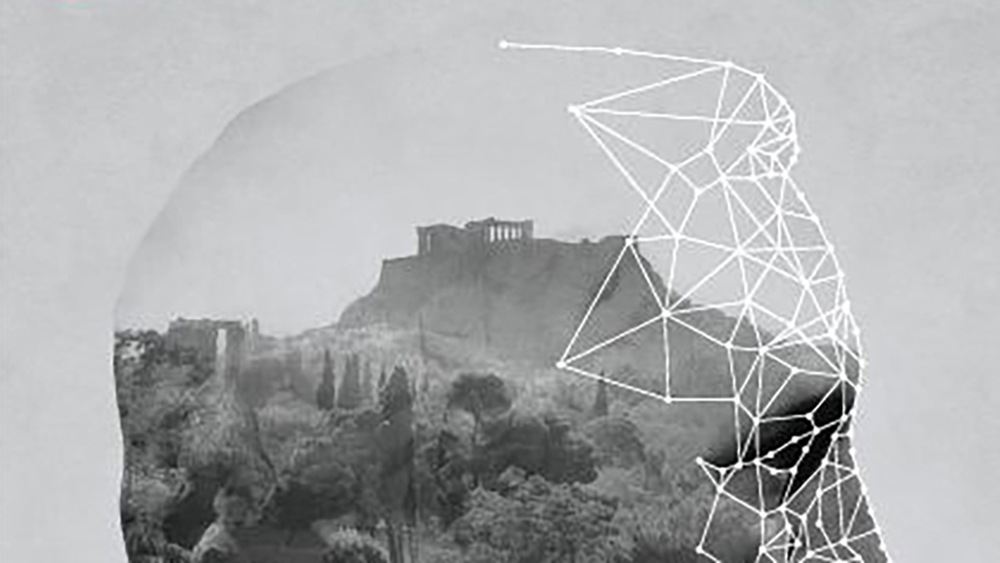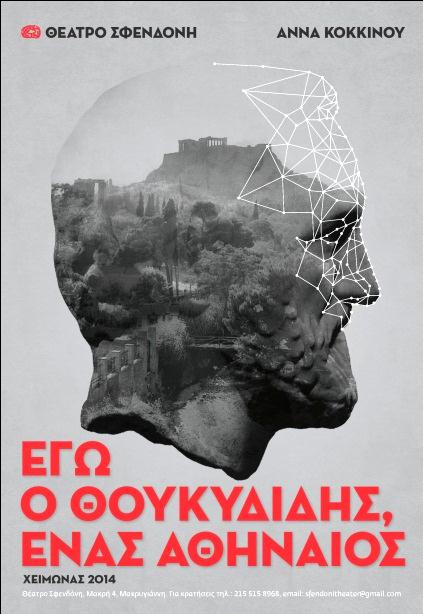
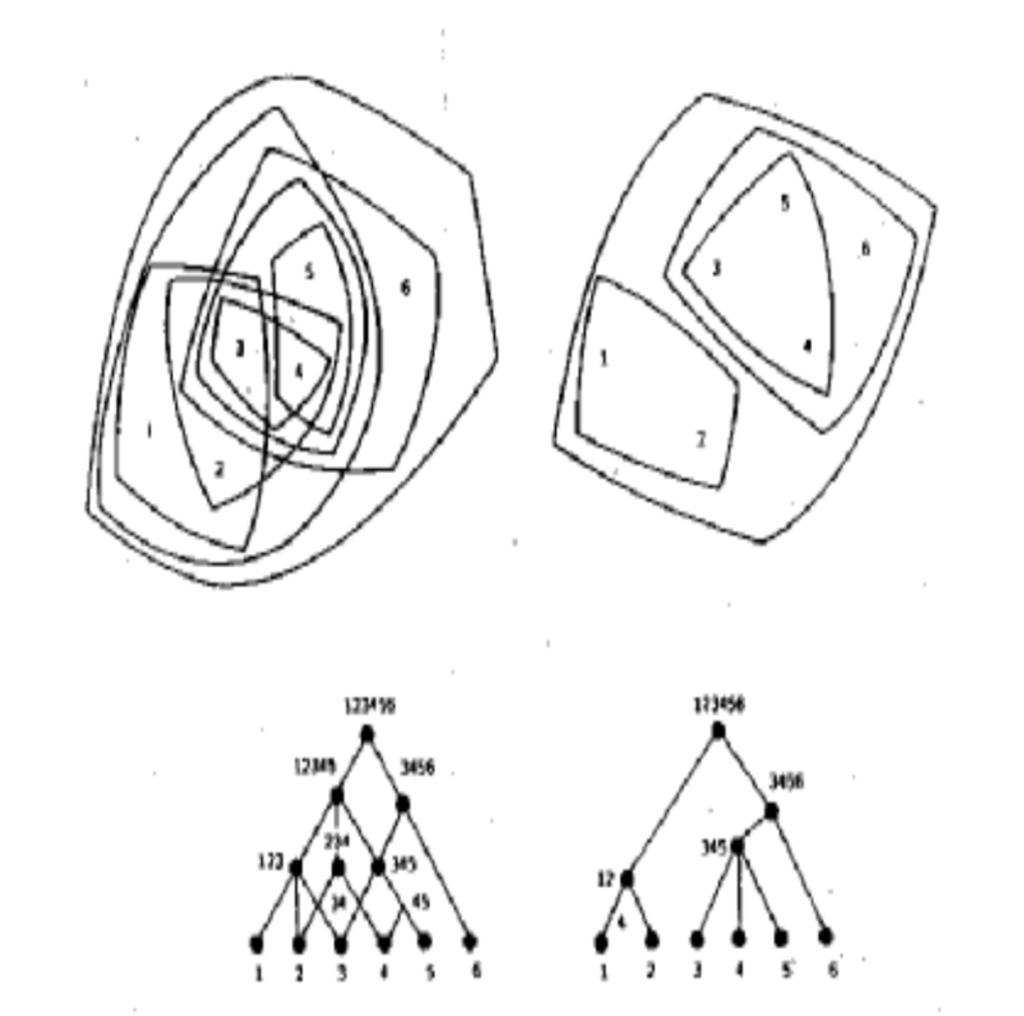
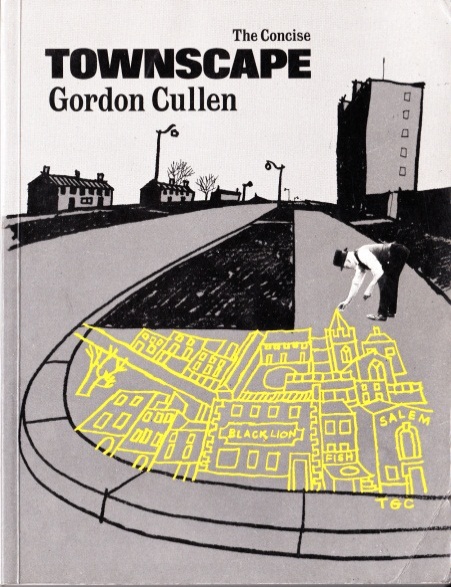
2. A City is Not a Tree
3. …a properly concentrated town.
Image (1): I Thucydides, an Athenian.
The ‘Golden Age’ of the city of Athens (broadly, 5th century BC) produced a participatory and public space-based democracy where (at least some) city residents were considered as equals, embellished the Acropolis with the Parthenon, and saw on its streets such great minds as Socrates, Euripides, Hippocrates and Herodotus.16 It also coincided with a ‘cold’ war 24 with the city of Sparta. To commemorate citizens who had died in the conflict an annual ‘funeral oration’ was held. The oration delivered by Pericles in 430 BC as mayor and recorded (and most likely embellished) by the historian Thucydides was though fundamentally different. Pericles did not merely pay reference to those dead warriors. Rather, he exalted the city of Athens itself – as a pinnacle social construct, with a dynamic, innovative and forceful character that then justified Athenians in distinguishing themselves from other Greeks.24,19,26
Athens was not the first large and influential urban area of course; but the oration is regarded as the first time a city, as an entity, was so overtly promoted within the collective consciousness of the inhabitants themselves.19 Historian Nicole Loraux proposes that the speech marks an ‘omnipotence’ of the polis, where the idea of “man” was replaced by the “citizen” in a ‘circular relationship’ in which each inhabitant was invited ‘to contemplate day by day the power of the city until they are filled with love for her…’21 (and in doing so, one also suspects, support the “war effort”).
It is a process nicely captured in this poster for a theatre production centred around the role of Thucydides (Image 1).27 Within his silhouetted headspace is not only an image of the Acropolis, Athens’ pride and joy, and the nearby locality where the orations were presented but also a “frontal lobe” representation of what we now know as the networked nature of how we make sense of and relate to the environments around us. It also conveniently introduces the work of the important contemporary urban theorist and practitioner Christopher Alexander, and the next image.
Image (2) A city is not a tree.
The work of Alexander has been introduced in a previous edition of this journal, given its resonance and practical usefulness in implementing the idea of the conscious city. This included a review of his most influential work, A Pattern Language and The Timeless Way of Building (published as a pair in 1977 and 1979 respectively4,5). Earlier research, A City is Not a Tree, published as a journal article in 1965 (over two editions)1, is regarded as equally “landmark”. It was re-published in 2016 with accompanying critical essays to mark its 50th anniversary.23
In A City is Not a Tree Alexander discusses the differences in how planned urban areas (which he saw as ‘artificial’ and increasingly unresponsive to our wellbeing) and more traditional urban areas (which he saw as ‘natural’ and fundamentally more supportive of our wellbeing) are conceptualised. The aim was to derive lessons for a process of contemporary city building more aligned with human needs. Drawing on set theory from his initial vocation as a mathematician Alexander used two geometric structures – the ‘tree’ and the ‘semi-lattice’, drawn in both “elevation” and “plan” format – as a tool to explore and explain (Image 2). Both structures are strongly geometric. However the expansion of understanding contained within the semi-lattice is significant.
Alexander concluded that traditional settlements gained their richness and efficacy as a result of the characteristic non-separateness of their physical and social parts and activities. The “mixed-up” nature of their urban form means that all these components overlap, and in doing so generate an increased number of connections – thus creating and supporting a diverse range of experiences and needs.
Alexander describes a contemporary observed small-scale example – how the convergence on a street corner of a drug/convenience store, a light-controlled pedestrian crossing, a newspaper rack, and pedestrians waiting for a ‘green’ light with nothing otherwise to do (except potentially look at and perhaps purchase a newspaper) all work together to create an interactive social economy and convivial addition to the urban living experience. The effect is similar to a grouping of activities that can occur around a bus stop, and which was translated into a pattern in A Pattern Language (and copied in an earlier article in this journal). Alexander’s street corner observations were also utilised in another pattern called “Corner Grocery”.
The semi-lattice structure gives a clear representation (and explanation) of the rich potential of such overlaps. In contrast, Alexander contends the structure of planned cities more resembles a “tree”, where overlap and connection is much reduced: ‘When we think in terms of trees we are trading the humanity and richness of the living city for the conceptual simplicity which benefits only designers, planners, administrators and developers. Every time a piece of a city is torn out, and a tree made to replace the semi-lattice that was there…the city takes a further step toward dissociation.’3 And further: ‘…the idea of overlap, ambiguity, multiplicity of aspect, and the semi-lattice, are not less orderly than the rigid tree, but more so. They represent a thicker, tougher, more subtle and more complex view of structure.’2
Alexander then suggests our urban areas are now being designed as “trees” rather than “semi-lattices” because designers (and managers) are inherently limited by the capacity of the human mind. It is not possible to visualise a full semi-lattice outcome in a single mental act; and so we retreat to the easier simplified and hierarchical (but ultimately deficient) structure of a tree. It was this design (and management) “consciousness” problem that Alexander then sought to address through his subsequent system of pattern languages.
Image (3): … a properly concentrated town.
Alexander’s abstracted semi-lattice is given more concrete representation in the next image – by Gordon Cullen, an urban designer who (like Alexander) was well aware of the power of a seductive drawing or phrase. Cullen’s best-known publication is The Concise Townscape (1961).6,17 It was his statement of antidote to how he saw cities were being developed with insufficient attention to the ‘art of relationship’ 7 (Cullen’s emphasis), both in relation to constituent physical elements and to the needs of inhabitants. And generating as a result cities characterised by a ‘boring’ ‘straightjacket’ of ‘conformity’.8
Cullen personalizes the resultant dilemma (Image 3). As he explained: “a victim of prairie planning traces out his public protest, the reminder of a properly concentrated town.’11 In response, Cullen explains how the design task is then the need to ‘join [all the elements] together into a new pattern created by the warmth and power and vitality of human imagination so that we build the home of man.’9 Resulting in a fundamental connectedness and differentiation, and an interplay of ‘Here and There’ and ‘This and That’.9
As he further states: ‘bring people together and they create a collective surplus of enjoyment; bring buildings together and collectively they can give visual pleasure which none can give separately.’7: again, the city as a collective enterprise. Cullen then goes on, again with seductive expression, to hint at a corresponding “consciousness” of mind for the aspiring practitioner: ‘As soon as [this]…dialogue is understood the whole place begins to shake hands with you. It bursts through the dull business of who did what and when and who did it first. We know who did it, it was chap with a twinkle in his eye.’10
The sequence: a chain of integrated experience.
Optic chain
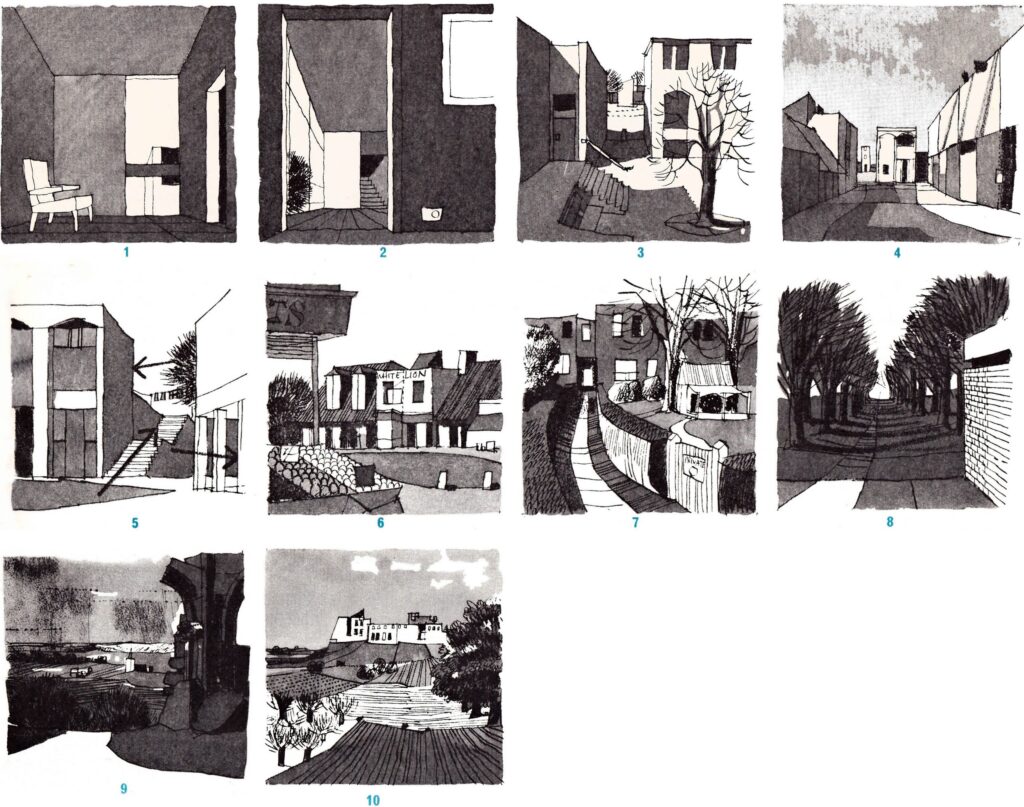
Integration chain
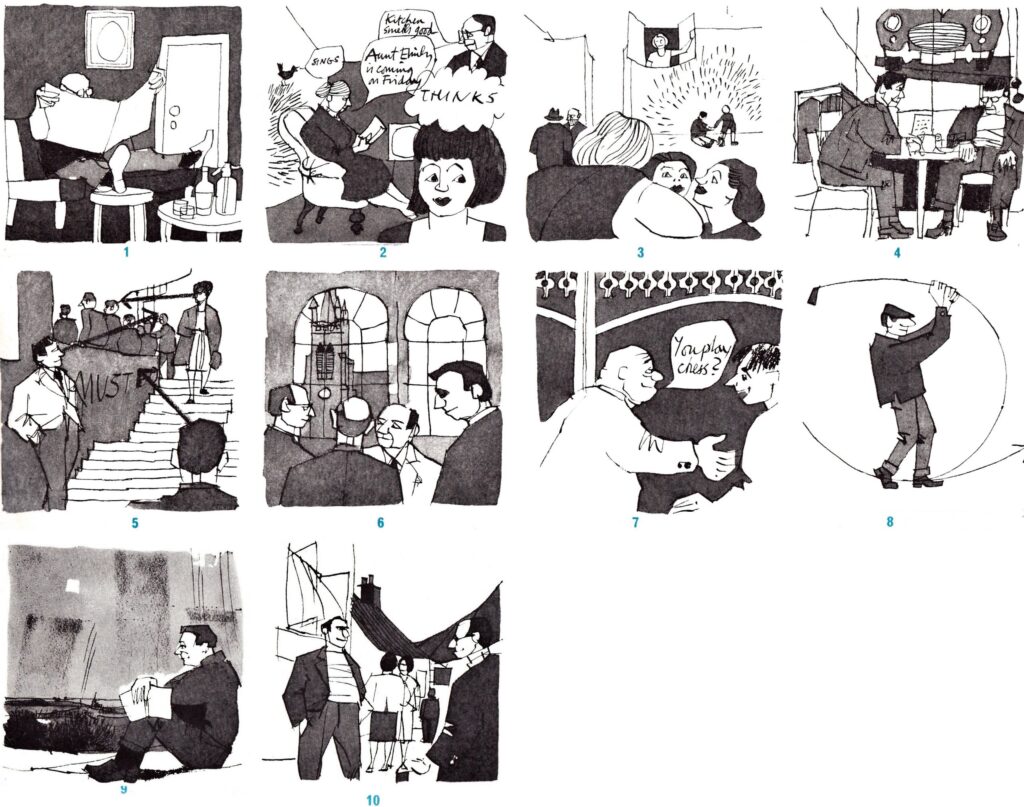
Between 1964 and 1968 Cullen also produced, on commission, three small guides on the urban process.12 In The Scanner 13 Cullen condensed the city-building task into a checklist of interrelated human and physical considerations to be used in the form of an enquiry: have I considered…? Although very much of their time and place, they do also (like Alexander’s patterns) identify various common fundamentals, arranged under “human factors” (tenure, work/leisure, association, integration, zests) and “physical factors” (community, pattern, landscape, optics and identity of place).
A key component is what Cullen terms the ‘integration’ and the ‘optic’ chains, reproduced above.15 They are inherently related and designed to be read together (Cullen also refers to the concept as a ‘serial vision’). One can see them as one strand from the myriad number of strands that make up any network (in this case the urban network); what Cullen is doing is extricating one and exploring its intricacies.
Each ranges from the intimacy of an individual room and peace with one’s own company to the expansive prospect and concurrent human desire for something bigger, with various stages of socialisation and associated spaces in between. They resonate with what more recent work refers to as variously ‘third spaces’ and ‘strong and weak ties’. Third spaces, identified by urban sociologist Ray Oldenburg24, are the multi-various and informal places outside of our often more isolated home and work environments where we can relax and get to know diverse others and in doing so generate friendships and other connections (and, he also posits, broader democracy). Sociologist Mark Granovetter18 has characterised such networks as being either “strong” (more structured) or “weak” (more casual), with the important conclusion that increased community connection and cohesiveness is facilitated by expanding our number of ‘weak’ rather than ‘strong’ interactions. Others have also described how such third spaces and weak ties, considered together, can result in a supportive “triangulation” that similarly grows community engagement and cohesion.25 And where, again, the whole becomes greater than the sum of its parts: ‘the city is more than the sum of its inhabitants. It has the power to generate a surplus of amenity, which is one reason why people like to live in communities rather than in isolation.’7
Usefully, Cullen’s chain image moves us beyond the all-too-frequent view of the key elements of urban living as somehow separate, and the resultant, again all-too-frequent, practice of designing urban plans and social programs also in a fragmented way. A process which then often becomes further embedded via ‘prophylactic by-laws [that] split open the fabric of the city’.14 And by association our wellbeing: an open space here, a community library there, shops and other activities over there, all “linked” by discontinuous transport systems and resulting in the “prairie planning” Cullen derides. What Cullen does is portray the true nature of the “conscious city” as a continuous flow of spaces and experiences, sensations and contacts – with oneself, with intimate others, and with broader family, social networks, nature and ultimately the numinous itself.
Conclusion: networks and diversity.
With this appeal for an inherent diversity in mind we also we find ourselves back in Athens for a final lesson, and caution. Instructively, Pericles’ exaltations were not without contemporaneous criticism. Plato for example thought the funeral oration was dangerous, “puffing up the public…with vain self-importance”.20 As Loraux also now suggests, Pericles’ attempt to create the city as its own identity required a vision of itself as a unity. But thinking of the city in this way and not as a community of individual pluralistic citizens or even as a collection of heterogeneous human groups “unconsciously”, and somewhat paradoxically, risks abandoning the collective democratic initiative that gave Athens its originality in the first place. As Loraux quotes from Aristotle, from his Politics II which itself was involved with the idea of the city:
It is not enough to have a number of men to make a city: they must also be different in kind: one cannot make a city from similar individuals.
It is clear… that a city, as it becomes ever more unified, will no longer be a city, for a city by its very nature is plurality.22
References
1 Alexander, C. (1965) A City is Not a Tree. Architectural Forum April & May (two separate editions), 1965:58-62.
2 Alexander, C. (1965) op. cit. p.62.
3 Alexander, C. (1965) op. cit. p.58.
4 Alexander, C. (1979). The Timeless Way of Building. Oxford University Press. Oxford.
5 Alexander, C., Ishikawa, S., Silverstein, M., Jacobson, M., Fiksdahl-King, I., & Angel, S. (1977). A Pattern Language. Oxford University Press. New York.
6 Cullen, G. (1961) The Concise Townscape. The Architectural Press. London.
7 Cullen, G. (1961) op.cit. p.7.
8 Cullen, G. (1961) op. cit. p.11.
9 Cullen, G. (1961) op cit. p.12.
10 Cullen, G. (1961) op. cit. p.15.
11 Cullen, G. (1961) op. cit. p.133.
12 Cullen, G. (1964-1968) A Town Called Alcan (various titles). Alcon Industries Limited. London.
13 Cullen, G. (1966) A Town Called Alcan (The Scanner). Alcon Industries Limited. London.
14 Cullen, G. (1966) op. cit. p.5.
15 Cullen, G. (1966) op. cit. pp.12-14. (The images here are reduced from the original which was printed over the length of two and a half A4-size pages in landscape format and do not reproduce well – try enlarging the images for a clearer reading).
16 Davies, N. (1997) Europe. A History. Pimlico, London.
17 Engler, M. (2016) Cut and Paste Urban Landscape: The Work of Gordon Cullen. Routledge. London.
18 Granovetter, M. (1973) The Strength of Weak Ties. The American Journal of Sociology. 78(6): 1360–1380.
19 Loraux, N. (1986) The Invention of Athens. The Funeral Oration in the Classical City. Trans. A. Sheridan. Harvard University Press. London.
20 Loraux, N. (1986) op. cit. p.265.
21 Loraux, N. (1986) op. cit. p.271.
22 Loraux, N. (1986) op. cit. p.278.
23 Mehaffy, M. W. (Ed.) (2016) A City is Not a Tree: 50th Anniversary Edition. Sustasis Press. Oregon.
24 Oldenburg, R. (1990) The Great Good Space: Cafes, Coffee Shops, Community Centers, General Stores, Bars, Hangouts, and How They Get You through the Day. Paragon House. New York.
25 Peters, M., Elands, B. & Buijs A. (2010) Social interactions in urban parks: Stimulating social cohesion? Urban Forestry & Urban Greening. 9(2).
26 Publications Michalis Toubis (1997) Athens. City of Intellect and Democracy. Myth and History. Athens.
27 Sfendoni Theatre, Athens. The play is I Thucydides, an Athenian, performed by Anna Kokkinou. The poster was sourced from the theatre’s website (now discontinued). It includes a photograph taken in 1910 of the area around the river lissos, near to the Acropolis, by Frederic Boissonnas and published in the Photographic Archive of the National Historic Museum 1859-1990.
References
- Demographic Yearbook of Poland 2019, Statistics Poland. https://stat.gov.pl/en/topics/statistical-yearbooks/statistical-yearbooks/demographic-yearbook-of-poland-2019,3,13.html

